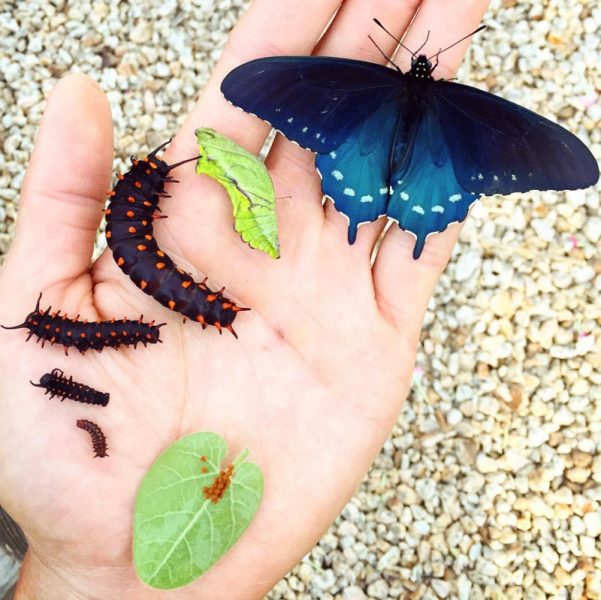
Wong displays the stages of the California Pipevine Swallowtail from egg to butterfly.
As part of his passion for butterflies, Aragon alumnus and conservationist Timothy Wong recently returned to Aragon to share his current work, the Butterfly Project, with Biotech 3-4 classes. The classes will participate in Wong’s ongoing project focused on repopulating the California pipevine swallowtail butterfly by planting its native plant species, the pipevine, here at Aragon.
After noticing the declining population of the pipevine swallowtail in San Francisco, Timothy Wong created his own butterfly enclosure in his backyard, growing the native pipevine plant and providing a healthy environment for the butterflies to repopulate. Since 2012, Wong has been the first in decades in this area to introduce and repopulate thousands of butterflies.

Biology teacher Katherine Ward says, “When he went viral … across the nation about the work he has done to repopulate the butterfly population in San Francisco, I was all for it … We got to thinking that this was something my Biotech 3-4 students are doing anyways — they are learning how to propagate plants and so it gave them the reason … to propagate plants — because you need to re-establish a habitat for organisms that are rare — and it gives us a chance to help him out.”
The Biotech Butterfly Project is an ongoing project that will last for approximately 10 years. Beginning by establishing an area at Aragon for the pipevine to grow, then possibly introducing butterflies to the reserve, this project will require students to collect data and understand the process of plant propagation. “I am excited to see that it is going to take a really long time,” says Senior Marissa Spadoni. “I am excited to come back, since I am a senior, in a high school reunion [to] see how they evolved over the years like all the plants and flowers and all the butterflies that are going to come.”
Because this is the first year the Biotech Butterfly Project is implemented in the Biotech 3-4 classes, there is considerable leeway for mistakes for students conducting the experiment. However, by also being the foundation of the project, this year’s students hold a special place. Junior Keertana Namuduri says, “I feel honored because we are starting an experiment that could make a big impact to the environment. There is not a lot of pressure because it is the first time we are trying this so it is not a big deal if it does not work out right away. But it is also kind of important that it works so that there is hope that the next years of Biotech will be able to make it work.”
Many of the experiments conducted in the Butterfly Project draw parallels to the lessons learned in the class. This project provides the platform for Biotech 3-4 students to apply materials learned in class to real life situations. Senior Kendison Ma says, “Right now we are learning about plants and how different ways to grow them, like fast-growing plants, so it fits perfectly in what we are learning about right now because we are growing the plants and finding different ways to clone it and make it faster.”
“I feel honored because we are starting an experiment that could make a big impact to the environment.
Wong has inspired Biotech 3-4 students to possibly pursue his conservation work as a career. Senior Alessandra Lynn says, “He just told us that it was an honor to be able to work with this species of butterfly and with all of these different people who are interested in it as well. That is really inspiring because it makes me think … how any kid here can grow up to be like him and it is kinda fascinating to think about how we all can change the world.”
By requiring students to apply their knowledge of biotechnology to real-life situations, the project introduced students to seeing how their class affects the outside world. Senior Kim Vo says, “In Biotech, we are always doing labs inside of class, it seems very routine at times. But seeing that we are helping out a project as a whole in the Bay Area, and especially since this lab procedure has gone viral, it really shows us that Biotech can affect the world.”
